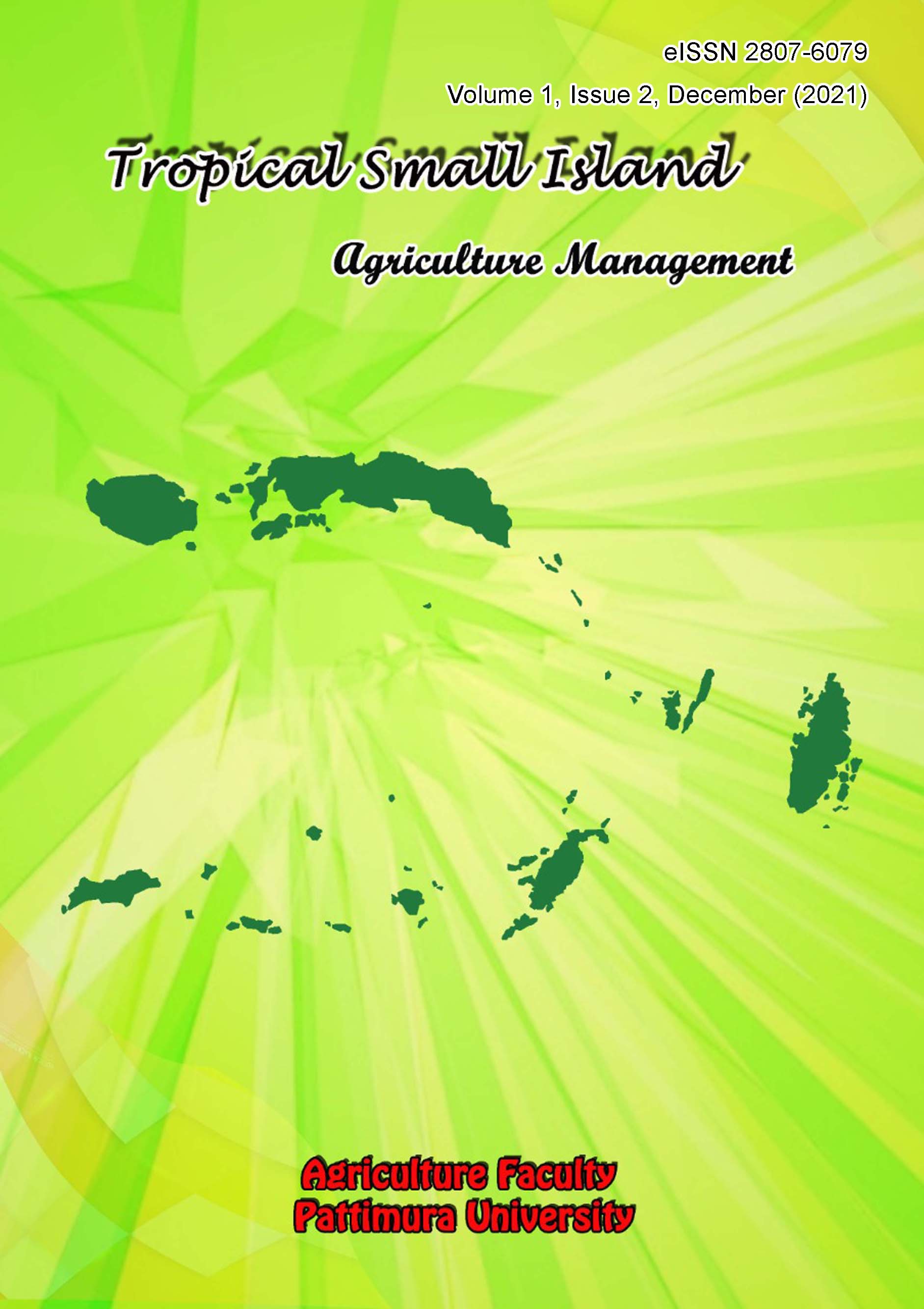Substitusi Pati Sagu dalam Pembuatan Mi Basah dengan Penambahan Sari Wortel (Daucus carrota L)
Substitution of Sagu Starch in the Production of Wet Noodles with the Addition of Carrot (Daucus carrota L)
Abstract
Wet noodles with carrot extract (Daucus carrota L.) are one of the diversified products from carrots to increase the added value. This study aimed to determine the best carrot extract treatment for making wet noodles. This study was designed using a completely randomized design with a single factor, namely the substitution of sago starch in the manufacture of wet noodles with the addition of carrot extract repeated twice. The results showed that based on the physicochemical results, the addition of 500 g carrots was the best treatment with a moisture content of 49.36%, an ash content of 1.26%, a protein content of 7.97%, a fat content of 1.21%, a carbohydrate content of 40.20%, a water absorption of 0.54%, and a cooking loss of 9.83%.
Downloads
References
AOAC. Association of Official Analytical Chemistry. (2012). Official Methods of Analysis of The Association of Official Analytical Chemistry. AOAC Arlington, Virginia.
Andarwulan, N., Kusnandar, F., Herawati, D. (2011). Analisis Pangan. Dian Rakyat. Jakarta.
Asmawati, Saputrayadi, A., & Bulqiah, M. (2019). Formulasi tepung tempe dan sari wortel pada pembuatan mie basah. Jurnal AGROTEK UMMAT, 6(1), 17-22.
Berlian, N. & Hartuti. (2003). Wortel dan Lobak. Penebar Swadaya. Jakarta.
Demirkesen, I., Mert, B., Sumnu, G., & Sahin, S. (2010). Utilization of chestnut flour in gluten-free bread formulations. Journal of Food Engineering, 101, 329-336.
Dewi, R. K., Hasyim Bintoro, M. H., & Sudradjat. (2016). Karakter morfologi dan potensi produksi beberapa aksesi Sagu (Metroxylon spp.) di Kabupaten Sorong Selatan, Papua Barat. Jurnal Agronomi Indonesia, 44 (1), 91 -97.
Diana, F.M. (2009). Fungsi dan metabolisme protein dalam tubuh manusia. Jurnal Kesehatan Masyarakat Andalas, 4(1).
Gopalakrishnan, L., Doriya, K., & Kumar, D.S. (2016). Moringa oleifera: A review on nutritive importance and its medicinal application. Food Science and Human Wellness, 5(2), 49-56. https://doi.org/10.1016/j.fshw.2016.04.001
Halim, M., Julianti, E. & Rusmarilin, H. (2014). Pembuatan mi ciam wortel dari tepung komposit terigu, pati ubi jalar, dan tepung kedelai yang digerminasi dengan penambahan sari wortel dan bahan pengental. Jurnal Rekayasa Pangan dan Pertanian, 2(2), 10-18.
Hasni, D., Nilda, C., & Amalia, J.R. (2022). Kajian pembuatan mie basah tinggi serat dengan subtitusi tepung porang dan pewarna alami. Jurnal Teknologi & Industri Hasil Pertanian, 27(1), 31-41.
Herlina, N., & Ginting M.H.S. (2002). Lemak dan Minyak. Sumatera: Fakultas Teknik Jurusan Teknik Kimia Universitas Sumatera Utara.
Husna, N.E., Lubis, Y.M., & Ismi, S. (2017). Sifat fisik dan sensory mie basah dari pati sagu dengan penambahan ekstrak daun kelor (Moringa oleifera). Jurnal Teknologi Industri & Hasil Pertanian, 22(2), 99-106.
Koswara, S. (2009). Teknologi Pengolahan Mie. eBook Pangan.
Li, J.H. & Vasanthan, T. (2003). Hypochlorite oxidation of field pea starch and its suitability for noodle making using an estrusion cooker. Food Research International, 36(4), 381-386. https://doi.org/10.1016/S0963-9969(02)00230-2
Marliyati, S.A., Sulaeman, A., & Rahayu, M.P. (2012). Aplikasi serbuk wortel sebagai sumber -Karoten alami pada produk mi instan. Jurnal Gizi dan Pangan, 7(2), 127–134.
Mulyadi, A.F., Wijana, S., Dewi, I.A., & Putri, W.I. (2014). Karakteristik organoleptik produk mi kering ubi jalar kuning (Iipomoea batatas) (kajian penambahan telur dan CMC). Jurnal Teknologi Pertanian, 15(1), 25-26.
Nasution, Z., Bakkara, T., & Manalu, M. (2006). Pemanfaatan wortel (Daucus carrota) dalam pembuatan mie basah serta analisa mutu fisik dan mutu gizinya. Jurnal Ilmiah PANNMED, 1(1), 9–13.
Picauly, P., Damamain, E., & Polnaya, F.J. (2017). Karakteristikk fisiko-kimia dan fungsional pati sagu ihur termodifikasi dengan heat moisture treatment. Jurnal Teknologi dan Industri Pangan, 28(1), 70-77. https://doi.org/10.6066/jtip.2017.28.1.70
Polnaya, F.J. (2006). Kegunaan pati sagu alami dan termodifikasi serta karakteristiknya. Jurnal Agroforestri, 1(3), 50-56.
Polnaya, F.J. (2013). Karakteristik Fisiko-Kimia dan Potensi Prebiotik Pati Sagu (Metroxylon rumphii) Fosfat. Disertasi. Fakultas Teknologi Pertanian, Universitas Gadjah Mada.
Polnaya, F.J., Huwae, A.A., & Tetelepta, G. (2018). Karakteristik sifat fisiko-kimia dan fungsional pati sagu ihur (Metroxylon sylvestre) dimodifikasi dengan hidrolisis asam. Agritech, 38(1), 7-15.
Pratiwi, Y., Rahim, A., & Hutomo, G. (2020). Karakteristik Fisik Dan Kimia Mie Antioksidan Dari Pati Sagu Dengan Ekstrak Kulit Buah Naga Merah. AGROTEKBIS: Jurnal Ilmu Pertanian, 5(3), 351-356. http://jurnal.faperta.untad.ac.id/index.php/agrotekbis/article/view/156
Rustandi & Deddy. (2011). Produksi Mie. Tiga Serangkai Solo.
Siregar, N.S. (2014). Karbohidrat. Jurnal Ilmu Keolahragaan, 13(2), 38-44.
SNI 2987:2015. (2015). Mi Basah. Badan Standardisasi Nasional, Jakarta.
Sudarmadji, S., Haryono, B., & Suhardi. (1989). Analisa Bahan Makanan dan Pertanian. Penerbit Liberty. Yogyakarta.
Sumantri. (2022). Analisis pendapatan usaha pengolahan sagu di kelurahan jaya kecamatan tellu wanua kota palopo. Jurnal Pertanian Berkelanjutan, 10(1), 42-51.
Warsito, H. K. S. (2019). Pembuatan klepon dengan substitusi tepung sagu sebagai alternatif makanan selingan indeks glikemik rendah. Jurnal Kesehatan, 7(1), 46.
Wierzbowska, J., Cwalina-Ambroziak, B., Głosek-Sobieraj, M., Sienkiewicz, S. (2017). Yield and mineral content of edible carrot depending on cultivation and plant protection methods. Acta Scientiarum Polonorum Hortorum Cultus, 16(2), 75–86.
Winarno F.G. 2008. Kimia Pangan dan Gizi. Jakarta: Gramedia Pustaka Utama.
Copyright (c) 2023 The Author(s)

This work is licensed under a Creative Commons Attribution-ShareAlike 4.0 International License.
Authors who publish with this journal agree to the following terms:
- Authors retain copyright and grant the journal right of first publication with the work simultaneously licensed under a Creative Commons Attribution License that allows others to share the work with an acknowledgment of the work's authorship and initial publication in this journal.
- Authors are able to enter into separate, additional contractual arrangements for the non-exclusive distribution of the journal's published version of the work (e.g., post it to an institutional repository or publish it in a book), with an acknowledgment of its initial publication in this journal.
- Authors are permitted and encouraged to post their work online (e.g., in institutional repositories or on their website) prior to and during the submission process, as it can lead to productive exchanges, as well as earlier and greater citation of published work (See The Effect of Open Access).









